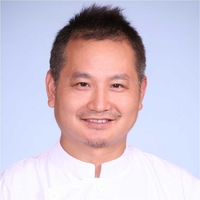夏登胜医生的科普号
- 精选 口服云南白药对下颌阻生智齿拔除术后面部肿胀影响的评价夏登胜 主任医师 北京口腔医院 急诊综合诊疗中心3227人已读
- 精选 锥形束CT定位埋伏牙的临床应用
锥形束CT在颌骨埋伏牙正畸治疗中的临床应用董辉 冯春丽 孙蕾 祁森荣 夏登胜(作者单位:100050 北京 首都医科大学口腔医学院综合科 [董辉 冯春丽 孙蕾 夏登胜] ;首都医科大学口腔医学院放射科 [祁森荣]通讯作者:夏登胜,E-mail:xdsh1202@yahoo.com.cn,电话:010-67099255摘 要: 目的: 探讨锥形束CT影像和三维重建技术对辅助拔除埋伏牙和正畸牙开窗术的作用。方法:临床选择53颗常规曲面断层片难以确定位的埋伏牙进行锥形束CT扫描,其中对5例复杂埋伏牙的CT图像进行三维重建。45例埋伏牙依据CT图像选择最短的手术入路径行拔牙术,8例埋伏牙采用颌骨开窗牵引术。结果:锥形束CT扫描对正确选择埋伏牙拔除的手术入路具有良好的指导作用,CT三维重建图像准确引导了手术开窗路径,缩短了牵引埋伏牙到正常牙列的时间。结论:锥形束CT成像技术和三维重建技术在显示埋伏牙的位置和牙体形态上明显优于传统的曲面断层和根尖片。Clinical value analysis of spiral CT in impacted maxilla tooth extraction and tooth artifistulationDONG Hui,FENG Chun-li, SUN Lei, QI Sen-rong, XIA Deng-sheng, Capital Medical University School of Stomatology, Beijing 100050, China [Abstract] Objective To explore the value of spiral CT and three-dimensional reconstruction in impacted maxilla tooth extraction and tooth artifistulation. Methods 53 cases with impacted maxilla teeth were examined by spiral CT before orthodontic treatment. Three- dimensional reconstruction of spiral CT images were performed in 5 complicated teeth artifistulation cases. Results The spiral CT images induced precise surgical approach for impacted tooth extraction .Three-dimensional reconstruction technique of spiral CT images simplified the procedure of tooth artifistulation. Conclusion Compared with traditional panoramic radiography and apical x-ray, spiral CT has more advantages in display the location of impacted tooth and tooth morphology in orthodontic treatment.Key words: Spiral CT, Maxilla impacted tooth, Three-dimensional reconstruction
夏登胜 主任医师 北京口腔医院 急诊综合诊疗中心1716人已读 - 精选 STA牙周膜注射在下颌埋伏阻生智齿拔除中的应用评价夏登胜 主任医师 北京口腔医院 急诊综合诊疗中心1972人已读
- 精选 salivary nitrate and stress夏登胜 主任医师 北京口腔医院 急诊综合诊疗中心1060人已读
- 精选 nitrate in salivary glands夏登胜 主任医师 北京口腔医院 急诊综合诊疗中心983人已读
- 精选 GDFs 促进牙周膜干细胞向韧带样细胞转化夏登胜 主任医师 北京口腔医院 急诊综合诊疗中心1022人已读
- 精选 Bone marrow soup rescure夏登胜 主任医师 北京口腔医院 急诊综合诊疗中心895人已读
- 精选 表皮生长因子促进干细胞增殖的研究夏登胜 主任医师 北京口腔医院 急诊综合诊疗中心1189人已读
- 精选 Long-term histological effects of nitrate supplementation in minipigs with parotid atrophy.
ABSTRACTBackground: Supplementation of nitrate in parotid atrophied patients is hypothesized to prevent pathological manifestations of the oral cavity and gastrointestinal tract. However, the long-term histological effect of supplementation on oral tissues and other systemic organs is unknown. Objective: The effects of long-term nitrate supplementation in minipigs with parotid atrophy are investigated in this study. Methods: Ten minipigs with induced parotid gland atrophy were randomized into two groups; minipigs in the first group were given a normal diet, while those in the second group were given 1 mol/L of nitrate daily. Samples of bodily fluids (saliva, serum, urine) were taken throughout the study. Minipigs were sacrificed after two years, and their oral cavities, stomachs, livers, kidneys and small intestines were sectioned for histological and electron microscopy analyses. Two minipigs without parotid atrophy were used as controls. Results: Nitrate levels in the saliva of parotid atrophied animals on a nitrate-supplemented diet returned to normal levels (17.3 ±3.9 ng/ul) in comparison to control minipigs (19.6 ±5.1 ng/ul). The same group of minipigs exhibited notably increased levels of nitrate in their blood and urine. These increased levels were significantly higher than those of the control group (blood: 11.5±1.5 vs 0.9±0.1 ng/ul, P<0.05; urine: 6014.0 ±1291.6 vs 31.1±0.4 ng/ul, P<0.001). Histological and electron microscopy analyses, however, showed no apparent abnormalities in organs of either experimental or control animals. Conclusion: Minipigs with parotid atrophy and nitrate supplementation regain normal levels of nitrates in their saliva with no concomitant histopathological changes in the oral cavity or in other systemic organs.
夏登胜 主任医师 北京口腔医院 急诊综合诊疗中心1572人已读 - 精选 涎腺非肿瘤疾病 专著
作者与导师王松灵等几位医生合作,共同详细介绍了涎腺非肿瘤疾病的起因、疾病临床表现、诊断和治疗方法。是一本关于涎腺非肿瘤疾病比较权威的一本专著
夏登胜 主任医师 北京口腔医院 急诊综合诊疗中心1967人已读





